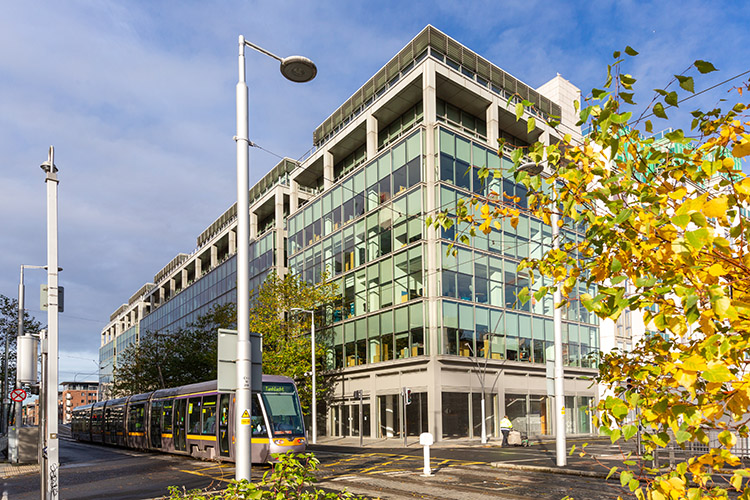

AOIFE O’NEILL, Divisional Director, Offices, Lisney, writes that the retrofitting of older commercial building stock presents considerable challenges, but these need to be addressed if Ireland is to meet its 2030 carbon emissions reduction targets.
It is fair to say that the office market in Dublin is recovering well in the aftermath of the Covid 19 pandemic, and it is certainly not obsolete as some predicted. The market is busy, with some firms taking substantial office space in Dublin to cater for their growth projections in the coming years.
The global climate crisis, compounded by the fact that competition for staff is at an all-time high in Dublin, has focused many businesses on developing cohesive environmental, social and governance (ESG) policies to attract staff and create a point of difference between competing companies. A growing number of businesses are participating in the UN’s Race to Zero campaign and signing up to its partner Pledge to Net Zero campaign, in which they are pledging to take rigorous, immediate action to halve global emissions by 2030. Real estate strategies will evolve as a result of this.
Race to Zero directly affects the office market, with occupiers looking for new energy-efficient space. This demand will drive up rents for newly constructed office space, with occupiers vying for the most energy-efficient and technologically advanced new stock.
This is all well and good for sectors like tech that are currently dominate the Dublin market, where revenue per employee makes the price of office space virtually insignificant. But it is concerning for other sectors and smaller businesses where margins are smaller. The gap is widening in the quality of accommodation in the market, which will make it harder for the other sectors to compete in Dublin’s already squeezed talent pool. New buildings offer best-in-class facilities that are attractive to staff. Features include gyms, showers and bicycle storage facilities, as well as access to outdoor space, which are all important, with an increased focus on staff well-being, particularly in the aftermath of the pandemic.
Demand for sustainable buildings is not specific to the office sector. Industrial occupiers have the same requirements, and we see premiums being paid for best-in-class new developments. We are likely to see demand also grow in the retail sector soon. However, this has been somewhat delayed by the detrimental effect that the pandemic has had on the sector. Relatively new asset classes to the Irish market, such as the private rental sector (PRS) and student accommodation, are also demanding better energy efficiency, with many investment funds that trade in these assets being obligated to meet minimum standards in sustainability.

ESG disclosure obligations
While occupier demand is focused on sustainability, the investment community has also shifted its focus, which is a vital driver for change.
The UN Principles for Responsible Investing (PRI) have been widely accepted, with the Global Real Estate Sustainability Benchmark (GRESB) used as a benchmark for the ESG performance of real estate assets. The Sustainable Finance Disclosure Regulation (SFDR) introduced by the European Commission imposes mandatory ESG disclosure obligations for asset managers and other financial market participants, with substantive provisions of the regulation effective from 10 March 2021.
This has changed what is considered an ‘institutionally acceptable asset’. From here on in, institutionally acceptable assets will need to meet specific sustainability criteria, likely resulting in a two-tier market with significant demand for sustainable and new net-zero buildings.
Office retrofit challenges
With distinct gaps emerging in both the occupier and investment markets and the need for radical retrofitting of existing building stock to meet climate targets, there needs to be a clear plan put in place to prioritise retrofitting in order to keep buildings from becoming stranded assets. The idea of this scares most landlords. This change in the market appears to have come as a surprise to many who have, to a substantial degree, been guilty of burying their heads in the sand on the issue.
Aside from the market demanding better accommodation, the devastating effects of climate change should be enough of a catalyst for change and drive the urgency of decarbonising existing commercial stock. All older stock, particularly buildings developed prior to the introduction of Nearly Zero Energy Building (NZEB), which mandates that all new buildings occupied and owned by public authorities shall be nearly zero energy buildings after 31 December 2018, and all other buildings by 31 December 2020, will need some form of retrofitting to reduce emissions. Ireland is legally obliged to become carbon neutral by 2050 and aims to reduce its emissions by 51% by 2030. The commercial sector needs to nearly half its greenhouse gas emissions by 2030 to meet our national targets. According to the Climate Action Plan 2021, the commercial sector, which includes all assets classes other than residential, was responsible for 900,000 metric tonnes of greenhouse gas emissions in 2018. The target is to reduce this to 500,000 metric tonnes by 2030.
Current market conditions
So, what is the state of play at present? The market is in a period of transition. Larger landlords and developers are leading the charge and hiring expertise to implement sustainability policies and changes required in their portfolios.
There appears to be an awareness in the rest of the market that change is happening, but the main question we are being asked is, “Where do I start?”.
As decarbonising existing stock is a relatively new concept, but one that is evolving fast, there is limited availability of knowledge and expertise.
The nature of the beast that is the commercial property market is that it needs time for churn and change. However, according to a recently published Intergovernmental Panel on Climate Change (IPCC) report, we are running out of time. It stated that now is the time for radical change, but, unfortunately, our industry is not well placed to deal with this quickly.
Office retrofitting solutions
The Climate Action Plan 2021 sets out a number of measures to support and incentivise the increased energy efficiency and decarbonisation of commercial buildings. But there are no quick fixes or immediately effective interventions to change things at the rate that is required.
The critical barriers to large-scale retrofitting identified in the government’s Long Term Renovation Strategy in 2020 were affordability, accessibility and appetite. Two years on, affordability remains an issue. The significant upfront capital cost of upgrade works isn’t possible for many, so increased low-cost financing options need to be made available to ease this pressure and increase appetite for upgrade works on a larger scale.
Naturally, the focus is on the residential sector, given its significant contribution to greenhouse gas emissions. But a similar scheme to the Residential Retrofit Low-Cost Loan Scheme would benefit the commercial sector. There needs to be increased awareness of the available financial supports and incentives. For instance, the uptake of accelerated capital allowances (ACA), which allow 100% of the capital expenditure incurred on energy-efficient equipment to be claimed for the year in which the equipment is first used, will be a significant help to occupiers, but there is limited awareness of these supports.
The Climate Action Plan 2021 states capital funding will be provided subject to exchequer resources. However, there is no detail on how this will be distributed. There is also the issue of who pays for these improvements in landlord and tenant situations with long-term lease agreements in place. Clearer guidance is required on these issues.
Appetite for change
But all that being said, there is hope.
We know that there is an appetite for change. Whilst upgrading the efficiency of buildings is the right thing to do in the face of the climate crisis, there are also significant commercial benefits to be gained.
Rapidly rising energy costs will boost demand for more efficient buildings to curb rising operating costs.
The most energy-efficient and advanced buildings outperform the rest of the market, attracting the best quality tenants and, in turn, increasing investment values. These performances will hopefully motivate others to upgrade their buildings to boost their performance.
There are opportunities to be gained from getting a firm grip on the concept of retrofitting.
The level of embodied carbon associated with new builds is typically about 60% of the overall carbon emissions from a building. These levels are unsustainable going forward.
We are already seeing brownfield sites containing older building stock being refurbished into smart, energy-efficient buildings, one example of this being IPUTs plans to refurbish A&L Goodbody’s North Wall, Dublin, offices, to be “Ireland’s most sustainable building”. This trend will continue to grow in the coming years.
Ultimately, the sooner that the required retrofitting skills and capacity are in place, as well as it being more financially viable to retrofit older stock, the better placed the commercial property sector will be to play a more substantial part in helping the country reach our emissions reductions targets by 2030 and 2050.
Lisney was established in 1934 and is one of Ireland’s oldest and leading firms of chartered surveyors with offices in Dublin, Cork and Belfast. Owned and operated by its directors, it provides commercial and residential advisory and agency services throughout the country. Lisney.com / (01) 638 2700



